Capitale est, comme son nom l'indique, le monde capitale du "Troisième Imperium" et le siège de son gouvernement depuis sa fondation en 4518 (an 0 du nouveau calendrier). Cette planète est située au centre astrographique de l'Imperium. Vers elle convergent toutes les communications, et elle possède la plus importante activité culturelle et industrielle de l'Imperium. Capitale est également le monde de la Garde Impériale, du Palais impérial, du Moot (le grand conseil consultatif) qui siège sur le plus haut bâtiment de la planète : la Flèche du Moot, une tour haute de 1,75 km.
Avant la fondation du "Troisième Imperium", ce monde se nommait Sylea, et était la demeure des Syléens, une race humaine mineure.
Les Syléens constituent une race humaine mineure, originaire de Sylea (renommée Capitale, secteur Coeur 2118). Bien que très tôt contactés par les Vilani, et annexés par le "Premier Imperium", de petits groupes de Syléens furent conservés/parqués dans des réserves sur Sylea. Ces tribus vivaient dans des zones inhospitalières et furent livrés à eux-mêmes car ne possédant rien de valeur aux yeux des envahisseurs.
Durant la longue période pendant laquelle ni les Vilani ni les Solomani ne commandaient à l'ensemble des mondes humains, les Syléens des réserves et des nationalistes de Sylea découvrirent une copie du Maar Ki Zon ou Livre de la Voie, un texte religieux datant d'avant le contact avec les Vilani (plusieurs milliers d'années auparavant). Cette religion aida les Syléens à gérer et conserver leur technologie dans l'isolement et l'obscurantisme. Au départ simple réseau commercial, les Syléens établirent bientôt une fédération qui devint finalement le "Troisième Imperium".
Les adeptes du Maar Zon, connus sous le nom de Lan Ki Zon ou Suiveurs de la Voie existent encore sur Sylea. Les Lan Ki Zon sont responsables du maintien de la culture syléenne jusqu'à nos jours.
Sources : http://wiki.travellerrpg.com/Capital_%28world%29, http://wiki.travellerrpg.com/Sylean
Mais le "Troisième Empire" pourrait également être l'Empire du Centre également connu sous le nom d'Empire de Canope. L'étoile Canopus, ou α Carinae, se situe à quelques 29000 années-lumière du centre galactique et à 310 du Soleil. C'est l'une des étoiles les plus brillantes dans le ciel terrien (après Sirius).
Sa quatrième planète, Throon, a été le siège des Rois des Etoiles et le point de départ des expériences scientifiques de Zarth Arn tels que décrits par Edmond Hamilton. Le nom "Throon" s'approchant du mot anglais "throne" (signifiant "trône"), il pourrait s'agir d'un surnom ou d'un nom honorifique pour marquer le nouveau statut de la planète; tel que Capitale au lieu de Sylea.
Quelques millénaires plus tard (de l'époque 4500-5600 aux environs de 10200-10600), ce même système sera le centre de toutes les attentions non pas à cause de sa verdoyante quatrième planète (Sylea/Capitale/Throon) mais à cause de son aride troisième planète Arrakis/Dune/Rakis, seul monde producteur de l'Epice de prescience indispensable aux humains pour voyager dans l'hyper-espace sans avoir recours aux navordinateurs conscients.
lundi 25 novembre 2013
dimanche 24 novembre 2013
Structure de l'atmosphère inférieure; hauteur et origine de l'astroport Terraport
Atmosphère
Une couche gazeuse, l'atmosphère, est maintenue par gravité autour du globe terrestre en rotation; sa pression et sa densité diminuent avec l'altitude. A 700 à 800 km au dessus du niveau de la mer commence le vide interstellaire: au delà, dans l'exosphère, les molécules ne sont plus maintenues par la gravité et s'échappent à travers la magnétosphère dans l'espace. Par commodité, on retiendra:
* 0 à 1000 km: atmosphère
* 1000 à 40000 km: exosphère et magnétosphère
Atmosphère inférieure
Entre 0 et 100 km d'altitude, les variations de température permettent de subdiviser l'atmosphère en plusieurs couches superposées:
* 0 - 7 km (au pôle) à 16 km (à l'équateur): la troposphère, avec des nuages, des précipitations, et des variations notables de pression; la température diminue régulièrement jusqu'à - 55°C; sa limite supérieure est la tropopause. Ses mouvements déterminent les climats.
* jusqu'à 50 km: la stratosphère; la température cesse de diminuer dans la stratosphère inférieure; elle augmente entre 30 et 50 km pour atteindre 0°C au niveau de la stratopause. La vapeur d'eau y est presque absente (pas de nuage), la pression y est trés basse (50 hPa à 20 km pour 1013 hPa au niveau de la mer); 95% de la masse de l'atmosphère est située au dessous de 20 km. La couche d'ozone est située au sommet de la stratosphère inférieure vers 25 à 30 km; les molécules d'oxygène absorbent les ultra-violets courts (au dessous de 0,29 µm) et produisent des atomes libres d'oxygène qui se recombinent aux molécules pour donner l'ozone.
Hauteur de Terraport
Terraport est une tour gigantesque de 25 km de haut fichée dans l'écorce terrestre et s'élevant jusqu'au sommet de la stratosphère inférieure, en pleine couche d'ozone. Elle permet aux vaisseaux spatiaux d'éviter les contraintes mécaniques de 95 % de la masse de l'atmosphère.
Origine de Terraport
Cette tour aurait été construite par les mystérieux Daimoni (d'une lointaine origine humaine terrienne), repartis dans l'espace aussitôt leur œuvre achevée.
A moins que cette structure colossale ne soit en réalité le vaisseau ogre de Khaal, l'empereur de l'humanité, alias Osiris. Il aurait littéralement enterré son engin voué à la destruction, comme on enterre la hache de guerre, dans l'écorce terrestre. Cet acte marquerait symboliquement le point de départ de la construction de son empire, et de la reconstruction de l'ancien empire disloqué de Leto II.
Les fameux Daimoni seraient alors tous ces "post-humains" ou "méta-humains" qui l'accompagnaient depuis la station-bagne ETHER d'où ils s'étaient échappés; sortes de Daïmôn pour l'ancienne humanité.
Sources : http://www.u-picardie.fr/beauchamp/mbg6/atmos.htm, http://okfirst.mesonet.org/train/meteorology/VertStructure.html et http://calypso1577.blogspot.com/2013/11/dimensions-du-vaisseau-orge-de-khaal.html ou encore http://www.fourth-millennium.net/cordwainer-vr/earthport-origin.html et http://cordwainersmith.blogspot.com/
Une couche gazeuse, l'atmosphère, est maintenue par gravité autour du globe terrestre en rotation; sa pression et sa densité diminuent avec l'altitude. A 700 à 800 km au dessus du niveau de la mer commence le vide interstellaire: au delà, dans l'exosphère, les molécules ne sont plus maintenues par la gravité et s'échappent à travers la magnétosphère dans l'espace. Par commodité, on retiendra:
* 0 à 1000 km: atmosphère
* 1000 à 40000 km: exosphère et magnétosphère
Atmosphère inférieure
Entre 0 et 100 km d'altitude, les variations de température permettent de subdiviser l'atmosphère en plusieurs couches superposées:
* 0 - 7 km (au pôle) à 16 km (à l'équateur): la troposphère, avec des nuages, des précipitations, et des variations notables de pression; la température diminue régulièrement jusqu'à - 55°C; sa limite supérieure est la tropopause. Ses mouvements déterminent les climats.
* jusqu'à 50 km: la stratosphère; la température cesse de diminuer dans la stratosphère inférieure; elle augmente entre 30 et 50 km pour atteindre 0°C au niveau de la stratopause. La vapeur d'eau y est presque absente (pas de nuage), la pression y est trés basse (50 hPa à 20 km pour 1013 hPa au niveau de la mer); 95% de la masse de l'atmosphère est située au dessous de 20 km. La couche d'ozone est située au sommet de la stratosphère inférieure vers 25 à 30 km; les molécules d'oxygène absorbent les ultra-violets courts (au dessous de 0,29 µm) et produisent des atomes libres d'oxygène qui se recombinent aux molécules pour donner l'ozone.
* 50 à 700 ou 1000 km: l'ionospère: la température y est variable, elle diminue généralement jusqu'à -90°C, mais on a signalé des températures supérieures à 100°C vers 55 km. A partir de 80 km, la température peut atteindre 300°C car les radiations courtes du soleil ne sont pas ré-émises sous forme de rayonnement de longue longueur d'onde (Infra-Rouges). Les atomes d'oxygène et d'azote sont ionisés sous l'action des ultra-violets solaires et des rayons cosmiques et donnent les aurores boréales et australes. Il y a plusieurs zones fortement ionisées qui conduisent l'électricité et réfléchissent les ondes radio vers le sol. L'ionospère est divisée en mésosphère (50 à 80 km) et thermosphère. Vers 800 km, on ne compte plus que 106 atomes au cm3 et seulement 1 atome par cm3 vers 2400 km.
Hauteur de Terraport
Terraport est une tour gigantesque de 25 km de haut fichée dans l'écorce terrestre et s'élevant jusqu'au sommet de la stratosphère inférieure, en pleine couche d'ozone. Elle permet aux vaisseaux spatiaux d'éviter les contraintes mécaniques de 95 % de la masse de l'atmosphère.
vue extérieure
vue intérieure
Origine de Terraport
Cette tour aurait été construite par les mystérieux Daimoni (d'une lointaine origine humaine terrienne), repartis dans l'espace aussitôt leur œuvre achevée.
A moins que cette structure colossale ne soit en réalité le vaisseau ogre de Khaal, l'empereur de l'humanité, alias Osiris. Il aurait littéralement enterré son engin voué à la destruction, comme on enterre la hache de guerre, dans l'écorce terrestre. Cet acte marquerait symboliquement le point de départ de la construction de son empire, et de la reconstruction de l'ancien empire disloqué de Leto II.
Les fameux Daimoni seraient alors tous ces "post-humains" ou "méta-humains" qui l'accompagnaient depuis la station-bagne ETHER d'où ils s'étaient échappés; sortes de Daïmôn pour l'ancienne humanité.
Sources : http://www.u-picardie.fr/beauchamp/mbg6/atmos.htm, http://okfirst.mesonet.org/train/meteorology/VertStructure.html et http://calypso1577.blogspot.com/2013/11/dimensions-du-vaisseau-orge-de-khaal.html ou encore http://www.fourth-millennium.net/cordwainer-vr/earthport-origin.html et http://cordwainersmith.blogspot.com/
Zhodani calendar
The Zhodani calendar measures the passage of time based upon their homeworld.
The basic unit for the Zhodani calendar is the zhdanstial (day): The time it takes for Zhdant to rotate once on its axis. It is equivalent to 1.12587 standard days or 27.02 standard hours.
The basic unit for the Zhodani calendar is the zhdanstial (day): The time it takes for Zhdant to rotate once on its axis. It is equivalent to 1.12587 standard days or 27.02 standard hours.
Year
The Zhodnai Chten (year) is 244.44 zhdanstial or 275.2 standard days in length.Olympiads
Three chten constitute one Thequzdij (olympiad) which is 733 zhdanstial in length, every third olympiad is 734 zhdanstial long.Seasons
The chten is also divided into six Shidr (seasons) which are each 40 zhdanstial long. Four Zhdanzhdanstial (holidays) separate the shidr without being part of any specific shidr. The weather which characterized the seasons is typical of the mid latitude climate of Dleqiats. The terms are now used more in the sense of months than of seasons, although certain weather characterizations remain attached to the words. The six seasons are:- Atrint (Raining): the season of spring rains and the planting of crops.
- Vrienstial (Heat): The (often stangant) hot summer season.
- Atchafser (Waning): A period when the hot summer weather breaks and tempers.
- Ataniebl (Harvest): The season to harvest mature crops.
- Atshtiavl (Chill): The freezing winter season.
- Atpaipr (Thaw): The meling of winter ice and thawing of frozen ground.
Holidays
The inter-seaons holidays have their origins in early Zhodani festivals and farming holidays. They are:- Dranshrin (Sunbright): The vernal equinox. Dranshrin is also the new year's day and takes place between Atpaipr and Atrint.
- Viepchaklstial (Moon day): Oringally a religious holiday associated with worship of Veipchakl, veipchaklstial is now a festival of wild abandon held between Atrint and Vrienstial.
- Dranzhrinatch (Sunflight): The autumnal equinox. Dranzhrinatch is a melancholy time for the commemoration of the dead. Dranzhrinatch takes place between Vrienstial and Atchafser.
- Kazdievlstial (Thanksgiving): A traditional harvest festival held between Ataniebl and Atshtiavl.
- Thequzastial (Olympiad Day): A special holiday inserted between Atshtiavl and Atpaipr every third year. Elections of consuls are announced on Thequzastial, as are winners of the Psionic Games. Every thrid olympiad Atlthequziastial (Double olympiad day) is added immediately after Thequzastial; its function is a leap year day to keep the calendar in synchronization, but its extends the Olympiad celebration as well.
Expressing Dates
Days within a season are individually named, but, for convenience, are also numbered from one to forty. A Zhodani date is expressed as Olympiad.Year Season/Day; (a holiday name replaces season/day if necessary).Imperial calendar
Calendar established at the creation of the Third Imperium as a universal calendar reform. Dates count from the founding of the Imperium, the year “zero ” Dates before zero are negative, dates after are positive. For example, Terra discovered jump drive in -2431. The Imperium was founded in zero.
The year is divided into 365 standard days, which are grouped into 52 weeks of seven days each The lengths of days and weeks is a legacy of Terran domination during the second Imperium. Days are numbered consecutively, beginning with one. The first day of the year is a holiday and is not part of any week. For example, the first day (Holiday) of the year 1116 is 001-1116. The last day of the year is 365-1116.
Days of the week are :
Source : http://wiki.travellerrpg.com/Imperial_calendar
The year is divided into 365 standard days, which are grouped into 52 weeks of seven days each The lengths of days and weeks is a legacy of Terran domination during the second Imperium. Days are numbered consecutively, beginning with one. The first day of the year is a holiday and is not part of any week. For example, the first day (Holiday) of the year 1116 is 001-1116. The last day of the year is 365-1116.
Days of the week are :
| Wonday | Tuday | Thirday | Forday | Fiday | Sixday | Senday |
Source : http://wiki.travellerrpg.com/Imperial_calendar
Date Conversion
Each Major Race uses their own dating system, rendering date conversion between systems necessary on occasion.
The Imperial Calendar is heavily influenced by the Solomani dating system, and borrows most of its basic timekeeping units. However, instead of numbering days within a year, as in Imperial practice, days are numbered inside a month, twelve roughly equal subdivisions of the year. Further, the length of the year is subtly different as Solomani calendar still periodically adjusts to synchronize with the sidereal period of Terra around Sol (365.2425 days, thus the Solomani year is 1.0006644 Imperial years). Because of this difference, the first day of the two calendars are 0.74 years apart as of 1116.
A Cycle (day) is a little over 22 hours. A year is 143 cycles, each cycle simply numbered 1 to 143 with no month or week divisions. Thus, a Hiver year is about half an Imperial one (0.49 specifically).
1105 is 1389 HF; 1111 is 1401 HF (from CT AM 7 HIvers).
Note that converting from a calendar that does not have a zero year
(e.g. Solomani, Vilani, Zhodani, K'kree) i.e. the 0 point is an instant
in time, rather than a complete year, must account for the "missing"
year when going from "negative" dates to positive ones.
Sources : http://wiki.travellerrpg.com/Date_Conversion
Calendars
Imperial
- Main article: Imperial calendar
Solomani
- Main article: Revised Gregorian Calendar
The Imperial Calendar is heavily influenced by the Solomani dating system, and borrows most of its basic timekeeping units. However, instead of numbering days within a year, as in Imperial practice, days are numbered inside a month, twelve roughly equal subdivisions of the year. Further, the length of the year is subtly different as Solomani calendar still periodically adjusts to synchronize with the sidereal period of Terra around Sol (365.2425 days, thus the Solomani year is 1.0006644 Imperial years). Because of this difference, the first day of the two calendars are 0.74 years apart as of 1116.
Vilani
The Vilani also count from the founding of the Empire Ziru Sirka. Each Vilani year is ~1.312 Solomani year.Zhodani
- Main article: Zhodani calendar
Aslan
- Main article: Aslan calendar
K'Kree
- Main article: K'kree calendar
Vargr
Vargr have no accurate calendar, so dating is meaningless, however a Vargr "year" is ~1.03 Solomani years.Droyne
The Droyne calendar likely should start around -75,000 Imperial, however the Droyne don't keep good records either.Hiver
- Main article: Hiver calendar
A Cycle (day) is a little over 22 hours. A year is 143 cycles, each cycle simply numbered 1 to 143 with no month or week divisions. Thus, a Hiver year is about half an Imperial one (0.49 specifically).
1105 is 1389 HF; 1111 is 1401 HF (from CT AM 7 HIvers).
Equivalent Dates
| Solomani | Imperial | Vilani | Zhodani | Aslan | K'Kree | Event |
|---|---|---|---|---|---|---|
| 3,659 BC | -8,145 | 3,148 PI | -639.1 | -5,442 | 1 | Start of K'Kree calendar |
| 2,213 BC | -6,731 | 2,046 PI | 1.1 | -5,301 | 1,186 | Start of Zhodani calendar |
| AD 1 | -4,520 | 361 PI | 981.2 | -2,779 | 3027 | Solomani calendar begins |
| AD 473 | -4,045 | 1 VI | 1,192.2 | -2,237 | 3,422 | Start of Vilani calendar |
| AD 2435 | -2,083 | 1,496 VI | 2,058.3 | 0 | 5,055 | Aslan calendar Begins |
| AD 4518 | 0 | 3,084 | 2,979.3 | 2,376 | 6,788 | Start of Imperial calendar |
Conversion Chart
Read down for date of origin, then across to calendar to convert.| Source (x) | Solomani | Imperial | Vilani | Zhodani | Aslan | K'Kree | Hiver |
|---|---|---|---|---|---|---|---|
| Solomani | n/a | (x - 4518) / 1.0006644 | |||||
| Imperial | (x * 1.0006644) + 4518 | n/a | (x + 4045)/1.312 | (x + 6731)/2.26 | (x + 2083) / 0.877 | (x + 8145) / 1.2 | (x - 410)*2 |
| Vilani | (x * 1.312) - 4045 | n/a | |||||
| Zhodani | (x * 2.26) - 6731 | n/a | |||||
| Aslan | (x * 0.877) -2083 | n/a | |||||
| K'Kree | (x * 1.2) - 8145 | n/a | |||||
| Hiver | (x/2) + 410 | n/a |
Sources : http://wiki.travellerrpg.com/Date_Conversion
588
| 588 Imperial | |
|---|---|
| Solomani: | 5,111 A.D. |
| Vilani | 3,531 VI |
| Zhodani: | 3,238.2 |
| Aslan: | 5,746 |
| K'kree: | 7,278 |
| Hiver: | 356 |
En l'an 588 du "Troisième Imperium" , la Terre, les autres planètes du système solaire et quelques systèmes planétaires proches (Barnard, Calgary, Dismal, Ember, Fenris, Forlorn, Hades, Heiphastos, Inferno, Junction, Loki, Midway, Peraspera, Prometheus, Sirius et Ys), dits de la "Ceinture fossile" ou encore "Sol-Cen-Sir", furent incorporés dans l'Empire.
On peut considérer que c'est la début de l'apogée pour le Troisième Imperium. Mais cet apogée ne durera qu'un ou deux siècles.
En effet, vers 5200-5300 (du calendrier terrien/chrétien), les homo novo commenceront à se séparer des différents homo sapiens ; les premiers pour se rapprocher de la République Galactique (quitte à humblement accepter de n'être qu'une espèce mineure), les seconds farouchement attachés à leur indépendance et à leurs mœurs belliqueuses.
Sources : http://wiki.travellerrpg.com/588 et http://wiki.travellerrpg.com/Old_Earth_Union_%28-1110_to_588%29
Near-Human
Most Near-Humans shared close external similarities to Humans, usually with small differences in skin and eye color or bone structure. Biologically, many Near-Humans were capable of interbreeding with baseline Humans. Some were close enough to the Human baseline to be considered a race or ethnic group of Humans, rather than a separate species. Similarly, some groups, biologically classified as Humans, though differing from the Human mainstream almost entirely in their culture, were considered so distinct that they were sometimes referred to as Near-Human.
History
The term "Near-Human" was used for species and races which had evolved significant physiological differences from baseline Humanity. It was also used for unrelated species, such as the plant-descended Zelosians, with substantial external similarities to Humans.Though Near-Humans were not Human in the strictest sense, their "almost human" status led to exceptions in the xenophobic and Humanocentric policies of the Galactic Empire. Not all Imperials accepted Near-Humans as equals, however: Grand Admiral Rufaan Tigellinus despised high-ranking Near-Human colleagues such as the part-Sephi Grand Moff Bertroff Hissa and the Chiss Grand Admiral Thrawn. Another Imperial Near-Human, Grand Admiral Danetta Pitta, kept his Borneck and Etti ancestry secret while ardently supporting Humanocentrism and Human High Culture. Calian shockboxer Lobar Aybock recalled an Imperial saying in his autobiography—"near human, not near enough."
Near-Human types
Chiss
Zeltrons
Others
Many other Near-Human races existed, each with their own similarities to and differences from the Human baseline. The Pau'an and Utai species of the planet Utapau, and the Sullustans of Sullust were among the species which, despite outward appearances, were classified as Near-Humans. The Zelosian species, though classified as Near-Humans, were in fact sentient, mobile plants. By contrast, other Near-Humans were close enough to baseline Humans to be identified as sub-groups of the Human species by some sources. These included the Hapans and the Lorrdians.Non-Human parallels
Humans were not the only sentient species to develop into several distinct races. The Duros, for example, gave rise to several Near-Duros races, such as the Neimoidians. Other pairs of closely related species included: the Xexto and the Quermians; the Horansi subspecies; the many races of the Nikto species; the Ranats and the Tintinna; the Ssi-ruuk and P'w'eck; the Sith and the Massassi; the Zolanders and the Clawdites; the Ewoks and Duloks; the Troob and the Hobors, and the Trandoshans and the Saurin. The t'landa Til and the Hutts were also related to one another, though more distantly. Although unsubstantiated, some in the New Republic speculated about a possible connection between the Yevetha and the Twi'leks.Behind the scenes
The Near-Human status of many "alien races" is not always certain. For instance, aliens who appear very similar to Humans may often be assumed by fans to be Near-Human, though this may never be explicitly stated in the canon. The confusion is compounded by the absence of any canonical explanation of what precisely "Near-Human" means. The definition could be as broad as a humanoid creature about the same size and bone structure of a Human, or could be more specific such as being able to biologically reproduce with a Human.The Utai look obviously non-Human, but are specifically described as Near-Humans in the Revenge of the Sith novelization. Some of this confusion comes from overlapping use of the terms "humanoid" and "Near-Human", both by in-universe sources and real-world writers.
An additional source of ambiguity are groups such as the Lorrdians and Hapans, who are described in different sources as either Near-Humans or as a fully Human racial or ethnic group.
The Twi'leks are frequently assumed to be Near-Human by fans, but no source has yet identified them as Near-Human. They are capable of producing hybrid offspring with Humans, however, such as Jek Lawquane and Shaeeah Lawquane.
Of course the real world explanation is simply that many characters in the Star Wars universe are Human actors wearing makeup, masks, or prosthetic appliances, making it difficult and expensive to create races that could not be a Human in a costume.
Humaniti
It has been fairly well established that the Ancients were responsible for transporting humans from Terra
to a number of other worlds. It is estimated that humans were taken to
more than a hundred worlds, with evidence of their presence on at least
90 worlds. On about 40 worlds, humans took root, surviving a period of
barbarism before achieving civilization.
Once the Solomani Hypothesis (which theorized that all humaniti came originally from Terra) was accepted, it was a simple matter to analyze the gene pools available to each of the distinct human races found on worlds other than Terra. Those studies have concluded that the Ancients visited Terra many times, taking groups of between 1,000 and 10,000 humans to each of perhaps 100 planets.
The reason for Ancient interest in humaniti is unknown. Theories involving humans as slaves, assistants, workers, even as pets have been advanced, but there is not enough evidence to support any specific conjecture.
The three most widespread human races are the Solomani (humans from Terra), the Vilani (humans from Vland), and the Zhodani (humans from Zhodane).
Once the Solomani Hypothesis (which theorized that all humaniti came originally from Terra) was accepted, it was a simple matter to analyze the gene pools available to each of the distinct human races found on worlds other than Terra. Those studies have concluded that the Ancients visited Terra many times, taking groups of between 1,000 and 10,000 humans to each of perhaps 100 planets.
The reason for Ancient interest in humaniti is unknown. Theories involving humans as slaves, assistants, workers, even as pets have been advanced, but there is not enough evidence to support any specific conjecture.
The three most widespread human races are the Solomani (humans from Terra), the Vilani (humans from Vland), and the Zhodani (humans from Zhodane).
Vilani
Zhodani
jeudi 21 novembre 2013
Forme des astéroïdes
Les formes des astéroïdes peuvent être plus ou moins
déterminées, comme la période de rotation, à
partir de la courbe de lumière. Pour les astéroïdes
suffisamment grands (D > 150km), la forme d'équilibre gravitationnelle
est la sphère. Par contre, la forme des astéroïdes plus
petits, issus des collisions, est certainement irrégulière.
Cependant, un certain nombre de fragments peuvent se réaccumuler,
sous l'effet de l'autogravitation et former un aggloméré
sphérique. C'est ce qu'on appelle un " tas de gravats " ou en anglais
rubble
pile.
Sur la base de l'analyse des courbes de lumière existantes, et de courbes de lumière synthétiques obtenues en laboratoire ou par synthèse numérique, Barucci et al. (1989) ont pu dégager la répartition moyenne des formes parmi les astéroïdes. La figure 6 illustre ces résultats.

Distribution des formes des
astéroïdes dans les quatre catégories : ellipsoïdes
(32%), sphéroïdes (23%), objets irréguliers (25%) et
les corps avec variation d'albédo (20%). (Barucci et al., 1989)
Source : http://www.imcce.fr/en/grandpublic/systeme/promenade/pages4/476.html
Sur la base de l'analyse des courbes de lumière existantes, et de courbes de lumière synthétiques obtenues en laboratoire ou par synthèse numérique, Barucci et al. (1989) ont pu dégager la répartition moyenne des formes parmi les astéroïdes. La figure 6 illustre ces résultats.

Source : http://www.imcce.fr/en/grandpublic/systeme/promenade/pages4/476.html
mardi 19 novembre 2013
First Imperium or Grand Empire of Stars a.k.a the Ziru Sirka
First Imperium or Grand Empire of Stars a.k.a the Ziru Sirka (-4045 to -2204).
The first major interstellar civilization, politically and culturally dominated by humans originating on Vland (Vland 1717). The jump drive was discovered on Vland in -9235. Immediately the Vilani discovered a number of interfertile and technologically primitive human races on worlds within 60 parsecs. These were gradually brought to a high-technology state with Vilani help and assimilated into a loose interstellar community bound by trade and common culture.
Eventually, the client races themselves explored beyond the local sphere, contacting and trading with still more races. These new races gained their technology without being assimilated into Vilani culture; the resulting increased friction eventually resulted in a series of wars beginning in about -5400.
In response to the threat, Vland began tightening its control of its trade sphere, and finally organizing it into a centralized state in -5273. This marked the beginnings of the First Imperium, although there was as yet no emperor. During the thousand year period of the Consolidation Wars, Vland conquered and absorbed its enemies until there were no longer any civilized states on its borders (except for a portion of the Vargr Extents, isolated from the Imperium by the Windhorn rift).
The last war ended in -4045, and the Vilani declared the establishment of an interstellar empire to govern all Vilani territory. Known as the Grand Empire of Stars or Ziru Sirka, Vilani dating begins at this point. With no exterior threats, the Ziru Sirka lasted for nearly 1800 years; at its height, which was attained soon after the end of the wars, the First Imperium contained 27 sectors and over 15,000 worlds.
However, the cost of maintaining centralized control over this vast expanse was cultural rigidity; exploration had ceased with the beginning of the wars; now scientific research slowed to a halt, and the beginnings of a hereditary caste system began to emerge. Civilization was in decline.
As long as there was no exterior threat, the Grand Empire was safe; but gradually, despite all efforts, technology leaked across the borders. New interstellar states arose, and the Imperium could no longer afford to absorb them. Gradually, the Imperium lost territory along its coreward and trailing marches. Then, in -2422, the Imperium was contacted along its rimward border by the Terrans, who had recently emerged into space. Terran expansionism led to a series of interstellar wars, which ultimately resulted in Terran conquest of the Imperium in -2204 and the founding of the Rule of Man.
The first major interstellar civilization, politically and culturally dominated by humans originating on Vland (Vland 1717). The jump drive was discovered on Vland in -9235. Immediately the Vilani discovered a number of interfertile and technologically primitive human races on worlds within 60 parsecs. These were gradually brought to a high-technology state with Vilani help and assimilated into a loose interstellar community bound by trade and common culture.
Eventually, the client races themselves explored beyond the local sphere, contacting and trading with still more races. These new races gained their technology without being assimilated into Vilani culture; the resulting increased friction eventually resulted in a series of wars beginning in about -5400.
In response to the threat, Vland began tightening its control of its trade sphere, and finally organizing it into a centralized state in -5273. This marked the beginnings of the First Imperium, although there was as yet no emperor. During the thousand year period of the Consolidation Wars, Vland conquered and absorbed its enemies until there were no longer any civilized states on its borders (except for a portion of the Vargr Extents, isolated from the Imperium by the Windhorn rift).
The last war ended in -4045, and the Vilani declared the establishment of an interstellar empire to govern all Vilani territory. Known as the Grand Empire of Stars or Ziru Sirka, Vilani dating begins at this point. With no exterior threats, the Ziru Sirka lasted for nearly 1800 years; at its height, which was attained soon after the end of the wars, the First Imperium contained 27 sectors and over 15,000 worlds.
However, the cost of maintaining centralized control over this vast expanse was cultural rigidity; exploration had ceased with the beginning of the wars; now scientific research slowed to a halt, and the beginnings of a hereditary caste system began to emerge. Civilization was in decline.
As long as there was no exterior threat, the Grand Empire was safe; but gradually, despite all efforts, technology leaked across the borders. New interstellar states arose, and the Imperium could no longer afford to absorb them. Gradually, the Imperium lost territory along its coreward and trailing marches. Then, in -2422, the Imperium was contacted along its rimward border by the Terrans, who had recently emerged into space. Terran expansionism led to a series of interstellar wars, which ultimately resulted in Terran conquest of the Imperium in -2204 and the founding of the Rule of Man.
The approximate size of the (Rakatan) Star Forge
The first of the following links shows us the relationship between the
maximum width of the Star Forge and that of its control tower.
The second compares the width of the control tower with an object of known proportions (the Hammerhead cruisers about to blast the heck out of it). Though there are inaccuracies due to the cruiser being closer to the camera than the tower, I wouldn't expect these inaccuracies to increase the total size of the Star Forge by more than 50%
First image tells us that the station is 72.5 times wider than its control tower.
Second image tells us that the tower's width is roughly half of a Hammerhead's length. A Hammerhead is apparently 315 meters long, according to Wookieepedia, so the tower is roughly 155 meters wide.
That leaves us with a total width for the Star Forge of slightly over 11 km and an height of around 28 kilometers, give or take a kilometer in either direction. Actual figures might be slightly higher, but for ballpark figures these are pretty good.
Sources : http://forums.spacebattles.com/threads/the-approximate-size-of-the-star-forge.215559/
et http://starwars.wikia.com/wiki/Star_Forge
The second compares the width of the control tower with an object of known proportions (the Hammerhead cruisers about to blast the heck out of it). Though there are inaccuracies due to the cruiser being closer to the camera than the tower, I wouldn't expect these inaccuracies to increase the total size of the Star Forge by more than 50%
First image tells us that the station is 72.5 times wider than its control tower.
Second image tells us that the tower's width is roughly half of a Hammerhead's length. A Hammerhead is apparently 315 meters long, according to Wookieepedia, so the tower is roughly 155 meters wide.
That leaves us with a total width for the Star Forge of slightly over 11 km and an height of around 28 kilometers, give or take a kilometer in either direction. Actual figures might be slightly higher, but for ballpark figures these are pretty good.
Sources : http://forums.spacebattles.com/threads/the-approximate-size-of-the-star-forge.215559/
et http://starwars.wikia.com/wiki/Star_Forge
Nombres de mondes (de haute technologie) de la République Galactique
Le Sénat galactique accueille les représentants de 1024 secteurs (2 puissance 10). Des secteurs qui comptent 50 mondes en moyenne. Cela représente donc 51 200 mondes de haute technologie mais le tableau de corrélation VTL/diamètre spatial/nombre de planètes indique seulement 2725 mondes de NT5 au LXXXVIIème siècle (celui de la Bataille de Yavin).
Cette différence signifie que les 2725 du tableau ne représentent que le nombre de mondes sous contrôle humain (ou à population majoritairement humaine). 2725 sur 51200 que compte la République Galactique, c'est 5% du total.
Par contre, toujours d'après ce tableau , au XCIème siècle, l'humanité connaît une révolution technologique, avec le passage à la super-science (du NT5 au NT6) : construction de Prima (en 9050), maîtrise de la propulsion Lehouine (en 9080), etc. Elle compte désormais 9427 mondes de haute technologie soit, à elle seule, plus de 18% des mondes de l'Ancienne République.
Au XCIIIème siècle, l'Empire atteint le seuil des 10000 mondes (c'est l'époque du Daym, de la planète Génésis, de l'histrion sexomorphe) mais il faut ajouter les 4000 mondes des Marches, les 4000 du Lansall, les 1800 de la Conféd, etc. Soit près de 20000 mondes en tout ! Les humains contrôlent 39% des mondes de l'Ancienne République.
Cette différence signifie que les 2725 du tableau ne représentent que le nombre de mondes sous contrôle humain (ou à population majoritairement humaine). 2725 sur 51200 que compte la République Galactique, c'est 5% du total.
Par contre, toujours d'après ce tableau , au XCIème siècle, l'humanité connaît une révolution technologique, avec le passage à la super-science (du NT5 au NT6) : construction de Prima (en 9050), maîtrise de la propulsion Lehouine (en 9080), etc. Elle compte désormais 9427 mondes de haute technologie soit, à elle seule, plus de 18% des mondes de l'Ancienne République.
Au XCIIIème siècle, l'Empire atteint le seuil des 10000 mondes (c'est l'époque du Daym, de la planète Génésis, de l'histrion sexomorphe) mais il faut ajouter les 4000 mondes des Marches, les 4000 du Lansall, les 1800 de la Conféd, etc. Soit près de 20000 mondes en tout ! Les humains contrôlent 39% des mondes de l'Ancienne République.
Dates clés de La Guerre des Etoiles (Star Wars)
8594 Sacre de l'empereur Palpatine (d'après le calendrier sullustain)
8613 (8594 + 19 années de règne) Bataille de Yavin. Un homme seul, Luke Skywalker, détruit la plus puissante machine de guerre jamais construite L'Etoile Noire (1er cassemonde de l'histoire, 120km de diamètre).
16387 avant J.-C. (25000 avant BY - 8613) Fondation de la République Galactique dite "Ancienne République" et aussi de l'Ordre Jedi.
8613 (8594 + 19 années de règne) Bataille de Yavin. Un homme seul, Luke Skywalker, détruit la plus puissante machine de guerre jamais construite L'Etoile Noire (1er cassemonde de l'histoire, 120km de diamètre).
16387 avant J.-C. (25000 avant BY - 8613) Fondation de la République Galactique dite "Ancienne République" et aussi de l'Ordre Jedi.
lundi 18 novembre 2013
Histoire du passé et du futur d'après Traveller
Ancient Times
-310,000 to -290,000 - Ancient civilization period. Human stock transplanted
During this time the Ancients create a multiworld rosette at Tireen (Knaeleng 2910), in the Vargr extents, an unfinished ringworld at Leenitakot (Hinterworlds 1432), and an incomplete sphereworld at Sphere (Nooq 3201) which is home to the Inheritors.
Pre Imperium
-10,011 (4,547 PI) - First Vilani space exploration
-9235 (3,955 PI) - Vilani discover jump drive
-7980 - First Zhodani space exploration
-6731 (1.1 Zhodani) - Zhodani dating begins with first Psionic Games
-5415 - (581.3 Zhodani) Zhodani discover jump drive
-5400 (1,032 PI) - Vilani start Consolidation Wars
-4698 - Hiver discover jump drive
-4142 - K'kree discover jump drive
First Imperium
-4045 (1 VI) - Vilani Consolidation Wars end. Ziru Sirka founded.
-4000 (1211.1 Zhodani) - First Zhodani Core Expedition
-4000 (35 VI) - Vilani stop exploration.
-3810 - Vargr discover jump drive (jump-1)
-2555 (AD 1961) - First manned space flight on Terra
-2530 - Vargr discover rosette at Tireen
-2499 (AD 2024[1]) - Treaty of New York (widely considered de facto start of Terran Confederation)
-2431 (AD 2087) - Solomani discover jump drive
-2422 (AD 2097[1]) - First contact between Vilani and Solomani at Barnard's Star
-2404 (AD 2114[1]) - First Interstellar War starts
-2400 (1249 VI, AD 2122[1]) - First Interstellar War ends
-2398 (AD 2124[1]) - United Nations on Terra changes its name to Terran Confederation; Terrans develop jump-2[1]
Second Imperium
-2204 (AD 2314) - Rule of Man begins
-2136 - First Aslan space exploration
-2029 to -2013 Hiver-K'kree War
-1999 - Aslan discover Jump Drive
-1776 - (AD 2742) Collapse of Rule of Man; Long Night begins
-650 - Sylean Federation founded on Sylea
Third Imperium
0 - Third Imperium established (T4 Setting) founded by Cleon Zhunastu
420 - First Survey of Imperium completed
589-604 - First Frontier War
615-620 - Second Frontier War
704 (AD 5222) - Solomani Autonomous Region Created
750 - Seventh Zhodani Core Expedition
871 - (AD 5389) - Solomani Confederation established
979-986 - Third Frontier War
990 - (AD 5508) - Solomani Rim War begins
1002 (AD 5520) - Siege of Terra. End of Solomani Rim War
1065 - Second Survey of Imperium completed
1082-1084 - False War (Fourth Frontier War)
1105 (Mongoose Traveller setting)
1107-1110 - Fifth Frontier War (CT Setting)
1116 - Strephon murdered by Dulinor. Start of Rebellion (MT Setting)
1130 - Collapse of the Third Imperium.
Post Third Imperium
1200 - Reformation Coalition Established (TNE Setting)
1221 - Foundation of the Fourth Imperium
Source : http://wiki.travellerrpg.com/History
-310,000 to -290,000 - Ancient civilization period. Human stock transplanted
During this time the Ancients create a multiworld rosette at Tireen (Knaeleng 2910), in the Vargr extents, an unfinished ringworld at Leenitakot (Hinterworlds 1432), and an incomplete sphereworld at Sphere (Nooq 3201) which is home to the Inheritors.
Pre Imperium
-10,011 (4,547 PI) - First Vilani space exploration
-9235 (3,955 PI) - Vilani discover jump drive
-7980 - First Zhodani space exploration
-6731 (1.1 Zhodani) - Zhodani dating begins with first Psionic Games
-5415 - (581.3 Zhodani) Zhodani discover jump drive
-5400 (1,032 PI) - Vilani start Consolidation Wars
-4698 - Hiver discover jump drive
-4142 - K'kree discover jump drive
First Imperium
-4045 (1 VI) - Vilani Consolidation Wars end. Ziru Sirka founded.
-4000 (1211.1 Zhodani) - First Zhodani Core Expedition
-4000 (35 VI) - Vilani stop exploration.
-3810 - Vargr discover jump drive (jump-1)
-2555 (AD 1961) - First manned space flight on Terra
-2530 - Vargr discover rosette at Tireen
-2499 (AD 2024[1]) - Treaty of New York (widely considered de facto start of Terran Confederation)
-2431 (AD 2087) - Solomani discover jump drive
-2422 (AD 2097[1]) - First contact between Vilani and Solomani at Barnard's Star
-2404 (AD 2114[1]) - First Interstellar War starts
-2400 (1249 VI, AD 2122[1]) - First Interstellar War ends
-2398 (AD 2124[1]) - United Nations on Terra changes its name to Terran Confederation; Terrans develop jump-2[1]
Second Imperium
-2204 (AD 2314) - Rule of Man begins
-2136 - First Aslan space exploration
-2029 to -2013 Hiver-K'kree War
-1999 - Aslan discover Jump Drive
-1776 - (AD 2742) Collapse of Rule of Man; Long Night begins
-650 - Sylean Federation founded on Sylea
Third Imperium
0 - Third Imperium established (T4 Setting) founded by Cleon Zhunastu
420 - First Survey of Imperium completed
589-604 - First Frontier War
615-620 - Second Frontier War
704 (AD 5222) - Solomani Autonomous Region Created
750 - Seventh Zhodani Core Expedition
871 - (AD 5389) - Solomani Confederation established
979-986 - Third Frontier War
990 - (AD 5508) - Solomani Rim War begins
1002 (AD 5520) - Siege of Terra. End of Solomani Rim War
1065 - Second Survey of Imperium completed
1082-1084 - False War (Fourth Frontier War)
1105 (Mongoose Traveller setting)
1107-1110 - Fifth Frontier War (CT Setting)
1116 - Strephon murdered by Dulinor. Start of Rebellion (MT Setting)
1130 - Collapse of the Third Imperium.
Post Third Imperium
1200 - Reformation Coalition Established (TNE Setting)
1221 - Foundation of the Fourth Imperium
Source : http://wiki.travellerrpg.com/History
dimanche 17 novembre 2013
4521 ou 4518 ?
The Traveller:5641 Project annonce que l'année 1120 du calendrier impérial correspond à l'année 5641 du calendrier terrien/chrétien; soit 4521 années d'écart.
Pourtant, sur le site Imperial Encyclopedia Traveller, dans l'article "History", c'est 4518 années d'écart qui sont retenues.
Quelle est la version officielle ?
La réponse se trouve dans le tableau de conversion des dates.
1) Le calendrier terrien/chrétien commence l'année 1 tandis que le calendrier impérial commence l'année 0;
2) et les années terriennes et les années impériales sont sensiblement différentes :
- une année terrienne dure 365,2425 jours,
- ainsi, l'année des Solomani vaut 1,0006644 année impériale (qui compte exactement 365 jours).
Cet écart de 0,2425 jour par an provoque un écart d'une année tous les 1460 ans ... et de trois années tous les 4380 ans.
Pourtant, sur le site Imperial Encyclopedia Traveller, dans l'article "History", c'est 4518 années d'écart qui sont retenues.
Quelle est la version officielle ?
La réponse se trouve dans le tableau de conversion des dates.
1) Le calendrier terrien/chrétien commence l'année 1 tandis que le calendrier impérial commence l'année 0;
2) et les années terriennes et les années impériales sont sensiblement différentes :
- une année terrienne dure 365,2425 jours,
- ainsi, l'année des Solomani vaut 1,0006644 année impériale (qui compte exactement 365 jours).
Cet écart de 0,2425 jour par an provoque un écart d'une année tous les 1460 ans ... et de trois années tous les 4380 ans.
Equivalence des dates
| Solomani | Imperial | Vilani | Zhodani | Aslan | K'Kree | Event |
|---|---|---|---|---|---|---|
| 3,659 BC | -8,145 | 3,148 PI | -639.1 | -5,442 | 1 | Start of K'Kree calendar |
| 2,213 BC | -6,731 | 2,046 PI | 1.1 | -5,301 | 1,186 | Start of Zhodani calendar |
| AD 1 | -4,520 | 361 PI | 981.2 | -2,779 | 3027 | Solomani calendar begins |
| AD 473 | -4,045 | 1 VI | 1,192.2 | -2,237 | 3,422 | Start of Vilani calendar |
| AD 2435 | -2,083 | 1,496 VI | 2,058.3 | 0 | 5,055 | Aslan calendar Begins |
| AD 4518 | 0 | 3,084 | 2,979.3 | 2,376 | 6,788 | Start of Imperial calendar |
samedi 16 novembre 2013
Les vaisseaux de Macross, sachez les reconnaître...
Par Youli le Sam
Je
vais me concentrer sur les vaisseaux de la série et du film, mais il
n'est pas impossible que je développe, sachant que l'on retrouve le
SDF-1 dans Macross 2, dans Macross Plus et que des vaisseaux de même
calibre se retrouvent dans Frontier.

Toute l'histoire de Macross débute avec ce vaisseau extraterrestre qui s'écrase sur Terre, sur une île du Pacifique, South Ataria, en 1999. Bien qu'en triste état, les gouvernements de la Terre comprennent qu'ils peuvent en tirer profit, unifient (apparemment contre l'avis de certains, c'est le sujet de Macross Zero) la planète et lancent un projet fou : remettre en état le vaisseau, en apprendre le plus possible, et se préparer à l'inévitable : une rencontre avec la race qui a construit le vaisseau en question. Les pièces, et sans doute objets trouvés à l'intérieur, prouvent sans doute qu'il s'agit de géants (ce qui expliquerait le développement des Variable Fighters).
L'île sert de lieu de "remise en forme", non qu'ils aient beaucoup de choix vu la taille de l'engin. Une ville, Macross, se développe autour du vaisseau, qui réunit civils et militaires liés au projet, mais pas seulement. Notez au passage ce cliché de 2009, et le fait que, oui, l'animation japonaise n'est pas toujours super chiadée

Le vaisseau est nommé SDF-1 pour Super Dimensionnal Fortress One (c'est aussi un clin d'oeil à la force d'auto-défense japonaise, appelée SDF pour Self Defense Force). Et le jour de son inauguration et de son premier vol, en effet, les Zentradi font leur apparition, attaquant l'île et semblant en vouloir au SDF-1. Ce n'est qu'en utilisant, sans savoir où ils vont se trouver, le moyen de transport transdimensionnel, et emportant avec eux l'île et une partie de l'océan, que le SDF-1 échappe à l'attaque ennemie.
Dans la série, c'est un vaisseau qui serait issu de la race ayant non seulement conçu génétiquement les Zentradi, mais également les Hommes, sur Terre. Un peuple contre lequel les guerriers géants se seraient retournés, il y a des millions d'années. Un vaisseau identique au SDF-1 est croisé à un moment dans la série, lorsqu'une expédition Zentrado-humaine est envoyée pour "voler" une usine sensée aider à la reconstruction, et à la réparation de cette improbable alliance.
Dans le film il semblerait que l'intrigue se soit simplifiée et que tout simplement ce sont les hommes (Zentradi) qui se battraient depuis des lustres contre les femmes (Meltrandi). Et le SDF-1 serait un vaisseau de Meltran échoué.
Le vaisseau meltran duquel serait issu le SDF-1...

Dans les deux cas, les hommes ont ajouté une capacité inédite, celle de modifier la configuration du vaisseau, pourtant énorme, afin de passer de mode Forteresse à robot. Si au départ la forme vaguement humanoïde n'était peut être pas voulue, c'est celle qu'on lui connait qui sera la norme même des années plus tard avec des plateformes de lancement pour les valkyries, lesquelles étaient un bateau de débarquement et carrément un porte-avion dans la série.


Le SDF-1 est grand, suffisamment pour accueillir la population de 50.000 âmes. Elle est composée des civils et des militaires qui vivent sur l'île où a été reconstruit le vaisseau. A l'intérieur même du vaisseau spatial va se reconstruire la ville de Macross, où la vie semble vouloir reprendre son cours. La forteresse s'appellera du coup MACROSS de même, bien souvent, toutes les forteresses humaines suivantes.
Le ARMD, un vaisseau qui se fait détruire facilement par les Zentradi dans les premiers épisodes de Macross la série TV mais qui sont les bras du SDF-1 dans le film.
Les navires postés autour de l'île, et transportés bien malgré eux dans l'espace, servent, dans la série, de bras au SDF-1. Nous avons le Prometheus et le Daedalus, l'un et l'autre transportent les valkyries et les destroids.
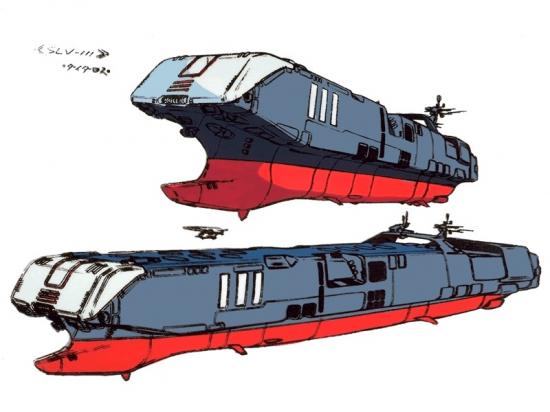
On trouve également le vaisseau de classe Oberth, éliminé rapidement et que l'on ne voit qu'au début de la série.

Cependant le SDF-1, aussi puissant soit-il, n'est rien en comparaison des gigantesques vaisseaux Zentradi, cent fois plus grands. Il en existe de différentes formes et tailles, pas loin de 5 modèles connus dans la série.
Petit rappel pour les proportions, un soldat Zentradi guidant l'atterrissage de Valkyries en position Gerwalk.

Les vaisseaux principaux dans la série (et un peu d'alphabet zentran tiens !)

Le vaisseau de Britai (Nupetitet Vergnitz)

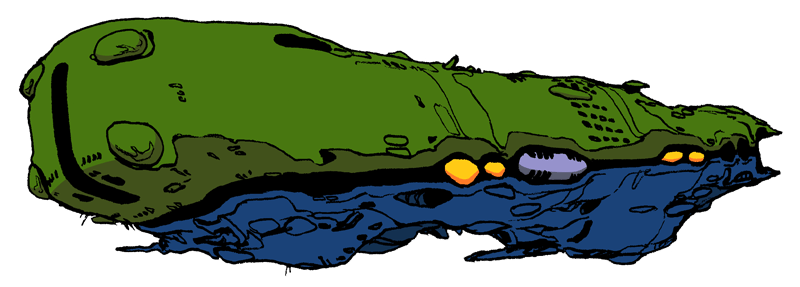
Différence essentielle entre la série et le film, ce vaisseau s'ouvre en deux, comme les autres, pour révéler son arme principale, dévastatrice, tout comme le SDF-1.

Le vaisseau de Exledor, Quiltra Queleual appelé aussi vaisseau de débarquement. On le reconnaît à son allure de Tanker ou de ballon dirigeable.

Le vaisseau de Kyron (Queadol Magdomilla). Sa particularité est de pouvoir se séparer en deux, la partie avant devenant un vaisseau à part entière.
Le vaisseau Standard

Un autre vaisseau, Tou Redir, nettement plus petit, qui sert de vaisseau éclaireur (et de chair à canon sans doute)

Et enfin un vaisseau, le Rineunadou Lojmeuean, tout aussi petit, qui foncera sur le SDF-1 à la fin de la série, et qui avait été remis en état par les forces rebelles de Kyron.
Il y a aussi des vaisseaux éclaireurs, des vaisseaux de récupération avec des bras même si on les voit au final assez peu.
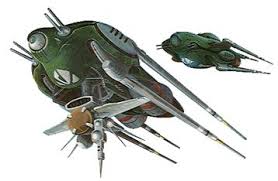

Les vaisseaux des Meltrandi sont identiques dans la série, si ce n'est pour la couleur, qui passe de vert à violet.
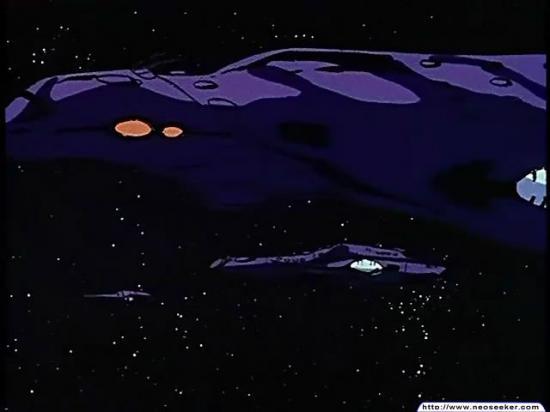
Dans le film les formes sont plus géométriques, plus élégantes, en opposition aux vaisseaux mâles plus organiques, et moins entretenus sans doute.

Il y a enfin la base principale de Bodolza, le chef suprême des Zentradi. C'est une sorte de gros caillou, presque de la taille d'une lune, qui peut contenir des millions de vaisseaux Zentradi.
Cette forteresse est très différente dans le film, plus organique, et est opposée à la forteresse géante des Meltrandi tout aussi énorme.
La base des Zentradi, de Bodolza.

La base des Meltrandi, de Laplamiz.

Dans les séries suivantes les vaisseaux vont prendre des proportions "zentradiennes", les humains, leurs descendants et les Zentradi micronisés ne vont pas se contenter de recoloniser la Terre mais également les alentours, avec l'envoi de caravanes spatiales menées par des vaisseaux de type SDF-1.
On voit un vaisseau nommé Megaroad dans Macross Flashback commandé par Misa Hayase (Lisa Hayes) et son escorte de VF-4. Macross Seven est la septième colonie envoyée dans la galaxie à la recherche d'une planète susceptible de les accueillir (ainsi qu'il a été fait sur Eden, que l'on voit dans Macross Plus). Les capacités de transformation semblent avoir été gardées, avec sans doute encore quelques améliorations pour les boucliers défensifs, les canons principaux, les bras en porte avion... On en voit encore plus de différentes sortes, et tailles, dans Macross Frontier qui nous en apprend encore plus sur l'expansion humaine dans l'univers.
Le SDF Megaroad

Le SDF-7 (la forme de tortue est voulue, la forteresse se détache en fait de la "carapace" pour passer en mode attaque, le placide reptile rappelle ici une légende indienne qui veut que le monde soit soutenu par des éléphants géants eux-mêmes placés sur une tortue géante et volante dans l'univers)

Dans Macross Frontier les choses ont encore évolué.
La colonie est composée de plusieurs vaisseaux, liés entre eux. Il y a une SDF, Macross 25 appelée aussi Macross Frontier qui est capable, comme ses ancêtres, de se transformer, mais avec une arme principale en forme de porte-avion (cool !).

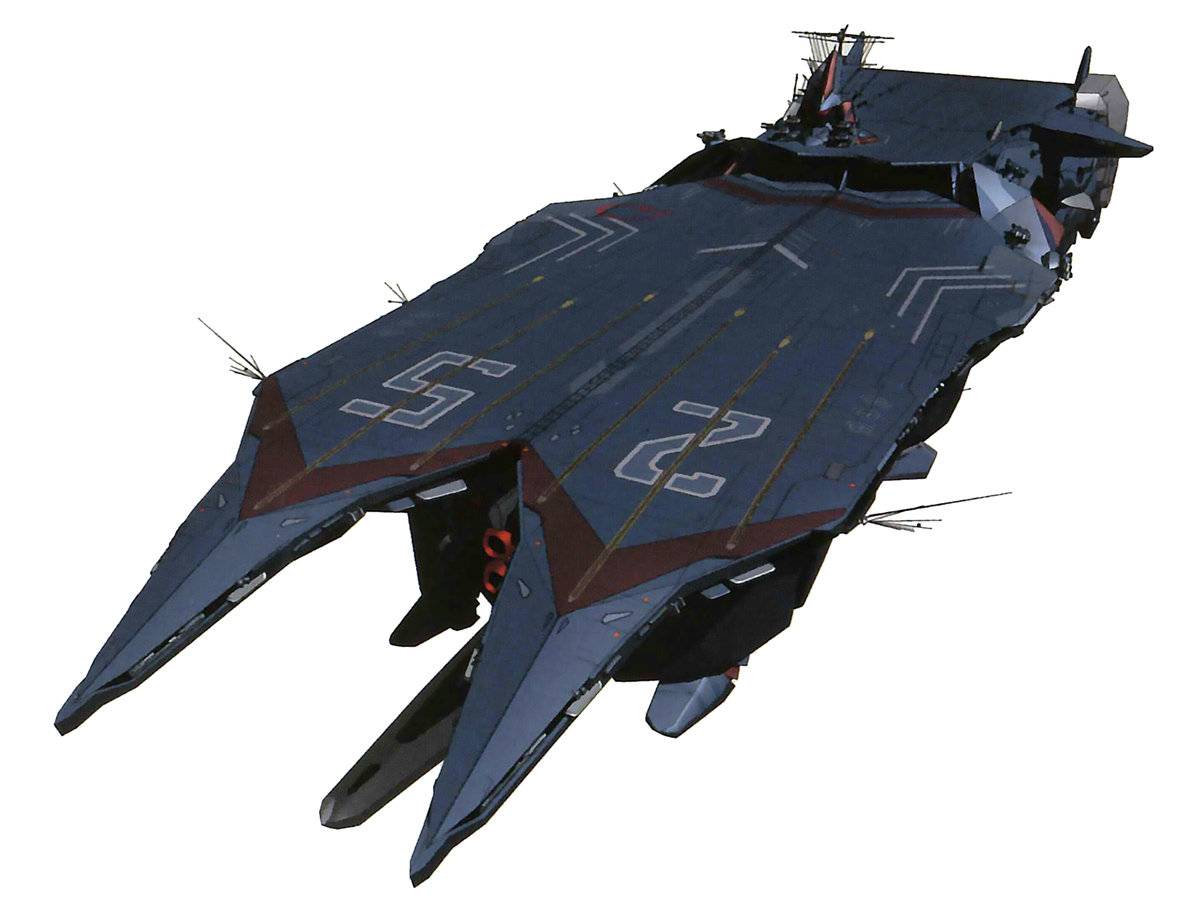
Tout cela fait des km, mais ce n'est que la tête de la tortue, élément principal des vaisseaux de colonisation.
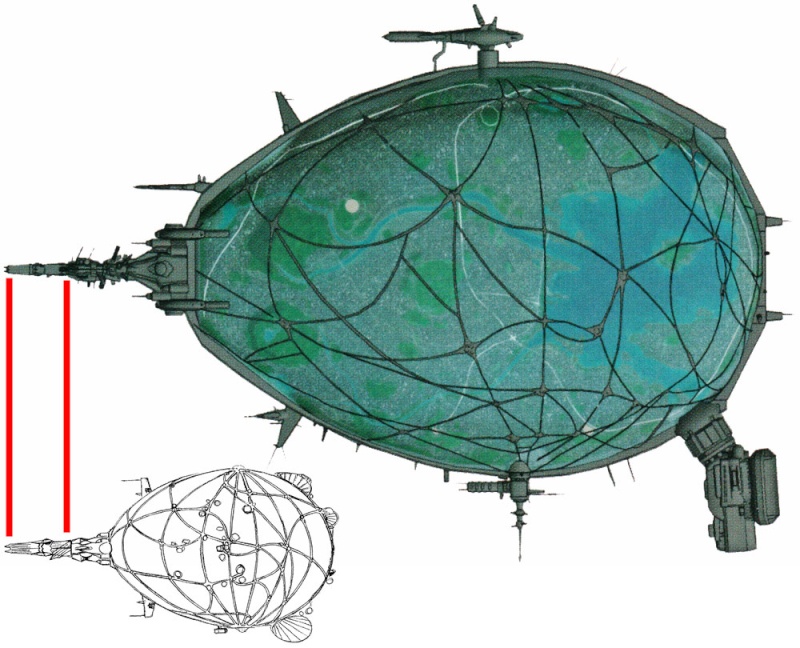
Il y a par contre une sorte de petit frère, Macross Quarter, sans doute parce qu'il est au 1/4 par rapport à une forteresse Macross classique. C'est le siège du SMS,

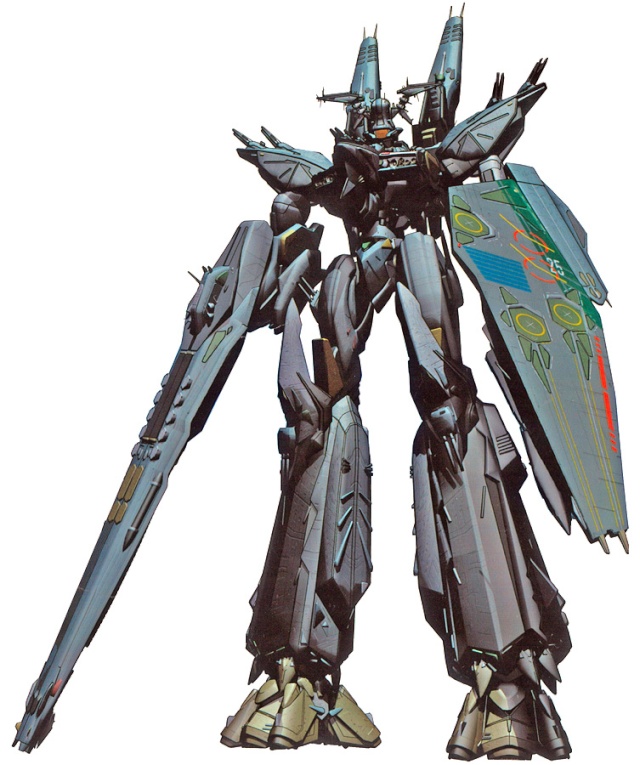
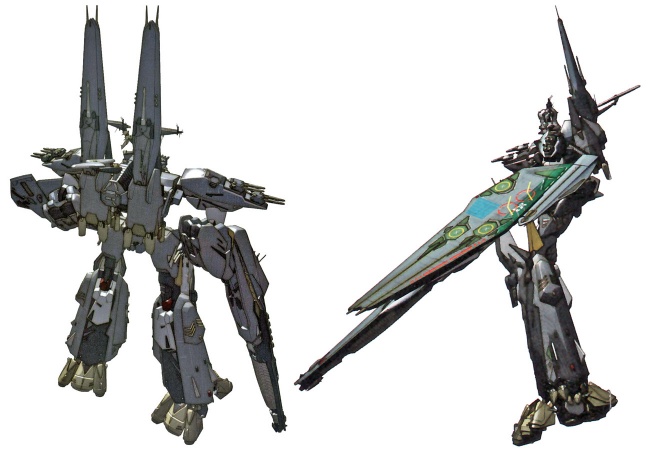
Réunion de famille...
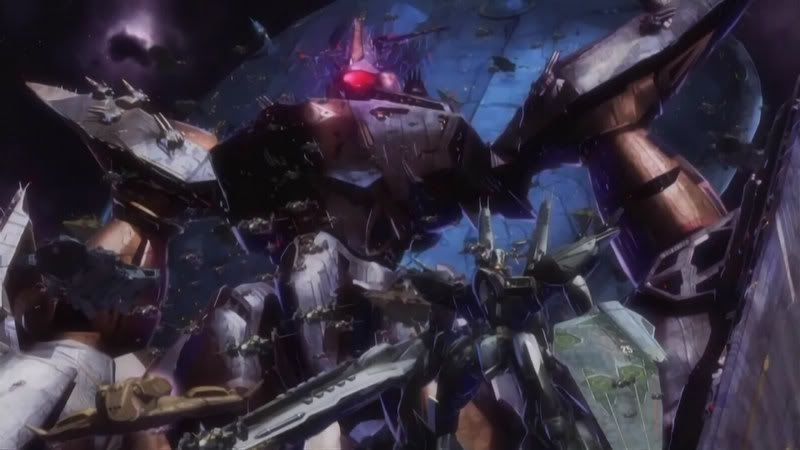
Enfin, chose merveilleuse avec Macross Frontier, c'est qu'il y a de nombreux épisodes qui font la jonction entre la série et le film, les différentes OAV, et un hommage aux personnages comme aux méchas qui ont forgé la légende de Macross.
J'en veux pour preuve l'épisode 13 de Macross Frontier où on découvre, échoué sur une planète où se sont rebellés quelques Zentradi mal conseillés, un SDF-4 appelé Global, comme le commandant du premier Macross. On voit bien ici qu'il a la même forme que le Macross original, du moins celui du film, et celui présent sur Terre.


Toute l'histoire de Macross débute avec ce vaisseau extraterrestre qui s'écrase sur Terre, sur une île du Pacifique, South Ataria, en 1999. Bien qu'en triste état, les gouvernements de la Terre comprennent qu'ils peuvent en tirer profit, unifient (apparemment contre l'avis de certains, c'est le sujet de Macross Zero) la planète et lancent un projet fou : remettre en état le vaisseau, en apprendre le plus possible, et se préparer à l'inévitable : une rencontre avec la race qui a construit le vaisseau en question. Les pièces, et sans doute objets trouvés à l'intérieur, prouvent sans doute qu'il s'agit de géants (ce qui expliquerait le développement des Variable Fighters).
L'île sert de lieu de "remise en forme", non qu'ils aient beaucoup de choix vu la taille de l'engin. Une ville, Macross, se développe autour du vaisseau, qui réunit civils et militaires liés au projet, mais pas seulement. Notez au passage ce cliché de 2009, et le fait que, oui, l'animation japonaise n'est pas toujours super chiadée

Le vaisseau est nommé SDF-1 pour Super Dimensionnal Fortress One (c'est aussi un clin d'oeil à la force d'auto-défense japonaise, appelée SDF pour Self Defense Force). Et le jour de son inauguration et de son premier vol, en effet, les Zentradi font leur apparition, attaquant l'île et semblant en vouloir au SDF-1. Ce n'est qu'en utilisant, sans savoir où ils vont se trouver, le moyen de transport transdimensionnel, et emportant avec eux l'île et une partie de l'océan, que le SDF-1 échappe à l'attaque ennemie.
Dans la série, c'est un vaisseau qui serait issu de la race ayant non seulement conçu génétiquement les Zentradi, mais également les Hommes, sur Terre. Un peuple contre lequel les guerriers géants se seraient retournés, il y a des millions d'années. Un vaisseau identique au SDF-1 est croisé à un moment dans la série, lorsqu'une expédition Zentrado-humaine est envoyée pour "voler" une usine sensée aider à la reconstruction, et à la réparation de cette improbable alliance.
Dans le film il semblerait que l'intrigue se soit simplifiée et que tout simplement ce sont les hommes (Zentradi) qui se battraient depuis des lustres contre les femmes (Meltrandi). Et le SDF-1 serait un vaisseau de Meltran échoué.
Le vaisseau meltran duquel serait issu le SDF-1...

Dans les deux cas, les hommes ont ajouté une capacité inédite, celle de modifier la configuration du vaisseau, pourtant énorme, afin de passer de mode Forteresse à robot. Si au départ la forme vaguement humanoïde n'était peut être pas voulue, c'est celle qu'on lui connait qui sera la norme même des années plus tard avec des plateformes de lancement pour les valkyries, lesquelles étaient un bateau de débarquement et carrément un porte-avion dans la série.


Le SDF-1 est grand, suffisamment pour accueillir la population de 50.000 âmes. Elle est composée des civils et des militaires qui vivent sur l'île où a été reconstruit le vaisseau. A l'intérieur même du vaisseau spatial va se reconstruire la ville de Macross, où la vie semble vouloir reprendre son cours. La forteresse s'appellera du coup MACROSS de même, bien souvent, toutes les forteresses humaines suivantes.
Le ARMD, un vaisseau qui se fait détruire facilement par les Zentradi dans les premiers épisodes de Macross la série TV mais qui sont les bras du SDF-1 dans le film.
Les navires postés autour de l'île, et transportés bien malgré eux dans l'espace, servent, dans la série, de bras au SDF-1. Nous avons le Prometheus et le Daedalus, l'un et l'autre transportent les valkyries et les destroids.

On trouve également le vaisseau de classe Oberth, éliminé rapidement et que l'on ne voit qu'au début de la série.

Cependant le SDF-1, aussi puissant soit-il, n'est rien en comparaison des gigantesques vaisseaux Zentradi, cent fois plus grands. Il en existe de différentes formes et tailles, pas loin de 5 modèles connus dans la série.
Petit rappel pour les proportions, un soldat Zentradi guidant l'atterrissage de Valkyries en position Gerwalk.
Les vaisseaux principaux dans la série (et un peu d'alphabet zentran tiens !)

Le vaisseau de Britai (Nupetitet Vergnitz)


Différence essentielle entre la série et le film, ce vaisseau s'ouvre en deux, comme les autres, pour révéler son arme principale, dévastatrice, tout comme le SDF-1.

Le vaisseau de Exledor, Quiltra Queleual appelé aussi vaisseau de débarquement. On le reconnaît à son allure de Tanker ou de ballon dirigeable.

Le vaisseau de Kyron (Queadol Magdomilla). Sa particularité est de pouvoir se séparer en deux, la partie avant devenant un vaisseau à part entière.
Le vaisseau Standard

Un autre vaisseau, Tou Redir, nettement plus petit, qui sert de vaisseau éclaireur (et de chair à canon sans doute)

Et enfin un vaisseau, le Rineunadou Lojmeuean, tout aussi petit, qui foncera sur le SDF-1 à la fin de la série, et qui avait été remis en état par les forces rebelles de Kyron.
Il y a aussi des vaisseaux éclaireurs, des vaisseaux de récupération avec des bras même si on les voit au final assez peu.

Les vaisseaux des Meltrandi sont identiques dans la série, si ce n'est pour la couleur, qui passe de vert à violet.

Dans le film les formes sont plus géométriques, plus élégantes, en opposition aux vaisseaux mâles plus organiques, et moins entretenus sans doute.

Il y a enfin la base principale de Bodolza, le chef suprême des Zentradi. C'est une sorte de gros caillou, presque de la taille d'une lune, qui peut contenir des millions de vaisseaux Zentradi.
Cette forteresse est très différente dans le film, plus organique, et est opposée à la forteresse géante des Meltrandi tout aussi énorme.
La base des Zentradi, de Bodolza.

La base des Meltrandi, de Laplamiz.

Dans les séries suivantes les vaisseaux vont prendre des proportions "zentradiennes", les humains, leurs descendants et les Zentradi micronisés ne vont pas se contenter de recoloniser la Terre mais également les alentours, avec l'envoi de caravanes spatiales menées par des vaisseaux de type SDF-1.
On voit un vaisseau nommé Megaroad dans Macross Flashback commandé par Misa Hayase (Lisa Hayes) et son escorte de VF-4. Macross Seven est la septième colonie envoyée dans la galaxie à la recherche d'une planète susceptible de les accueillir (ainsi qu'il a été fait sur Eden, que l'on voit dans Macross Plus). Les capacités de transformation semblent avoir été gardées, avec sans doute encore quelques améliorations pour les boucliers défensifs, les canons principaux, les bras en porte avion... On en voit encore plus de différentes sortes, et tailles, dans Macross Frontier qui nous en apprend encore plus sur l'expansion humaine dans l'univers.
Le SDF Megaroad

Le SDF-7 (la forme de tortue est voulue, la forteresse se détache en fait de la "carapace" pour passer en mode attaque, le placide reptile rappelle ici une légende indienne qui veut que le monde soit soutenu par des éléphants géants eux-mêmes placés sur une tortue géante et volante dans l'univers)

Dans Macross Frontier les choses ont encore évolué.
La colonie est composée de plusieurs vaisseaux, liés entre eux. Il y a une SDF, Macross 25 appelée aussi Macross Frontier qui est capable, comme ses ancêtres, de se transformer, mais avec une arme principale en forme de porte-avion (cool !).


Tout cela fait des km, mais ce n'est que la tête de la tortue, élément principal des vaisseaux de colonisation.

Il y a par contre une sorte de petit frère, Macross Quarter, sans doute parce qu'il est au 1/4 par rapport à une forteresse Macross classique. C'est le siège du SMS,



Réunion de famille...

Enfin, chose merveilleuse avec Macross Frontier, c'est qu'il y a de nombreux épisodes qui font la jonction entre la série et le film, les différentes OAV, et un hommage aux personnages comme aux méchas qui ont forgé la légende de Macross.
J'en veux pour preuve l'épisode 13 de Macross Frontier où on découvre, échoué sur une planète où se sont rebellés quelques Zentradi mal conseillés, un SDF-4 appelé Global, comme le commandant du premier Macross. On voit bien ici qu'il a la même forme que le Macross original, du moins celui du film, et celui présent sur Terre.

D'autres
vaisseaux font leur apparition dans Macross II Lovers Again dont des
SDF qui semblent faits à partir de vaisseaux zentradien, ce qui pourrait
être logique, vu la matière première à disposition, mais diablement
grand quand même...
Là, c'est quand même rien de moins que QUATRE vaisseaux Nupetiet Vergnitz, alias le vaisseau amiral de Breetai.




D'autres vaisseaux des vilains pas beaux Malduks


Là, c'est quand même rien de moins que QUATRE vaisseaux Nupetiet Vergnitz, alias le vaisseau amiral de Breetai.




D'autres vaisseaux des vilains pas beaux Malduks


Inscription à :
Articles (Atom)



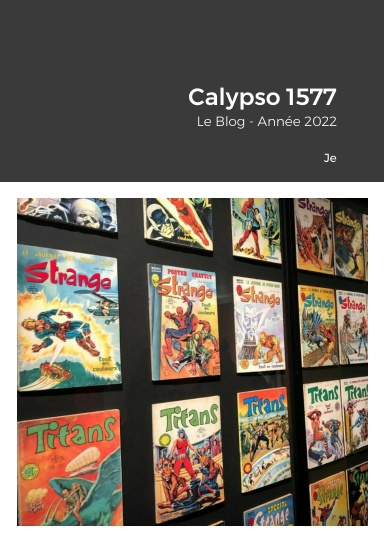






























.png)







